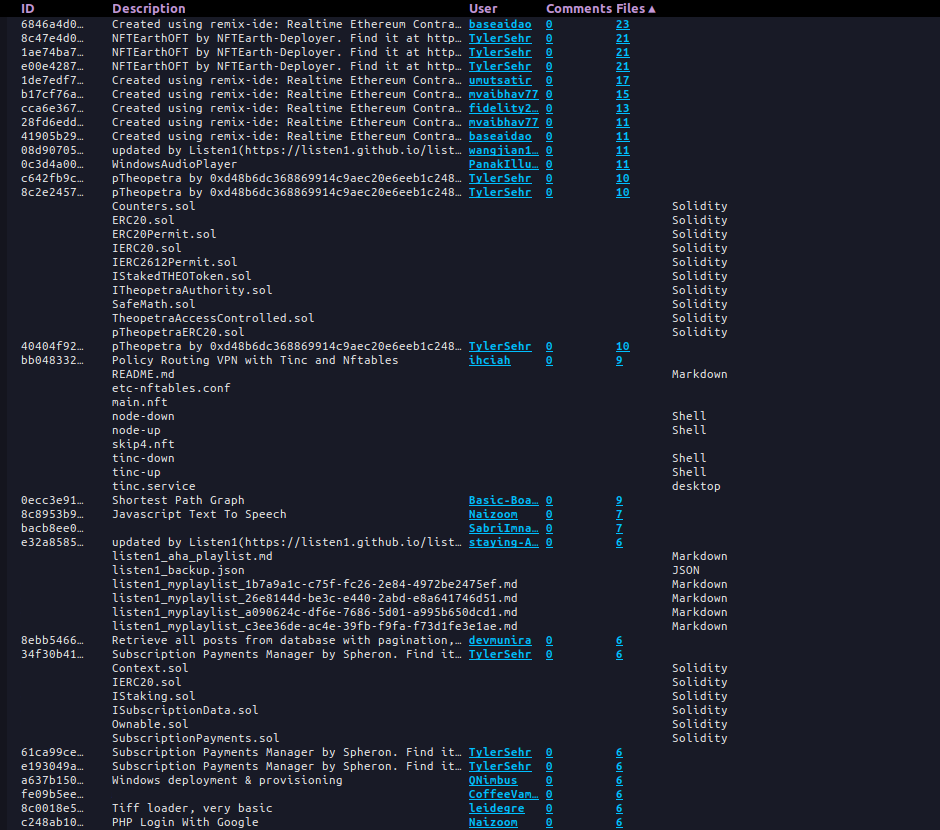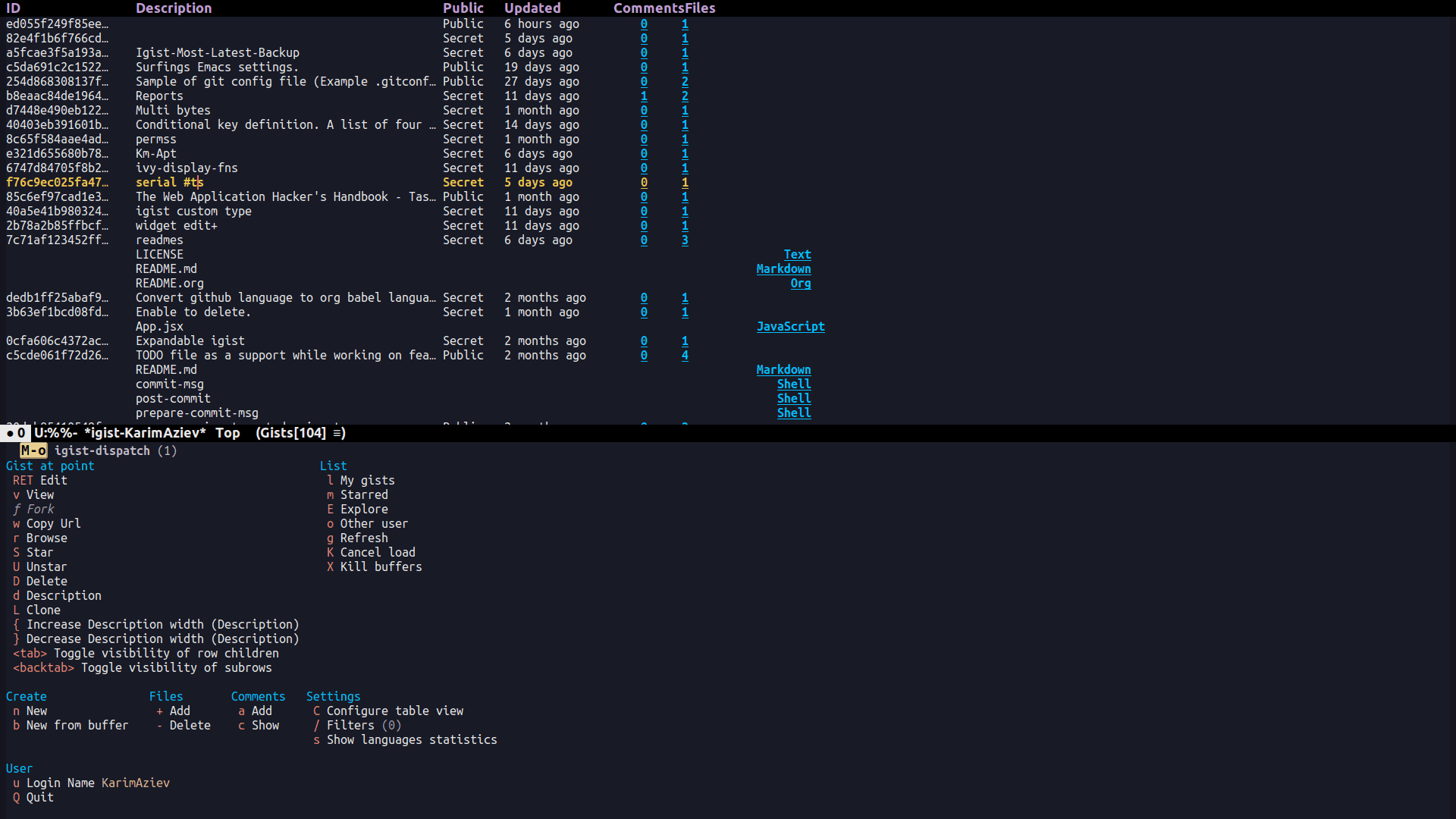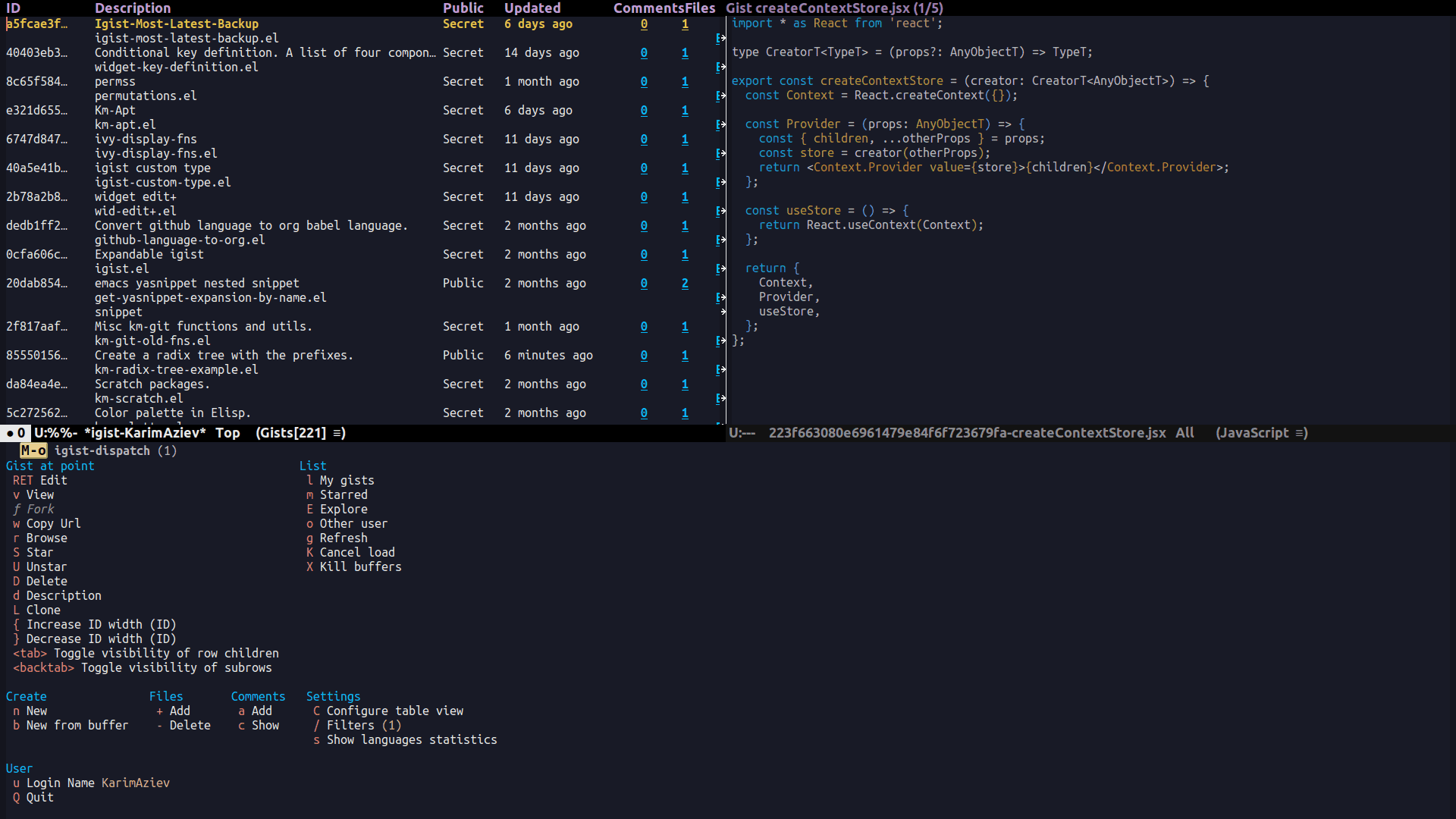igist is a modern package that aims to help you never leave Emacs to manage your GitHub gists.
- Emacs >= 27.1
- ghub
- transient
- Github API token
igist is available on MELPA.
To get started, enable installing packages from MELPA:
(require 'package)
(add-to-list 'package-archives '("melpa" . "https://melpa.org/packages/") t)
(package-initialize)
To fetch the list of packages you can do:
<M-x> package-refresh-contents
And after that igist can be installed with:
<M-x> package-install igist
Download the repository and it to your load path in your init file:
(add-to-list 'load-path "/path/to/igist")
(require 'igist)(use-package igist
:bind (("M-o" . igist-dispatch)))Or if you use straight.el:
(use-package igist
:bind (("M-o" . igist-dispatch))
:straight (igist
:repo "KarimAziev/igist"
:type git
:host github))igist manages authentication through two customizable variables:
igist-current-user-name: This variable should be set to a string containing your GitHub username.igist-auth-marker: This variable can either be a string containing the OAuth token or a symbol indicating where to fetch the OAuth token.
Firsly, you need to ensure that you have a GitHub API token with scope gist:
- Log in to your GitHub account and navigate to settings.
- Select the Developer settings option on the bottom of the sidebar.
- Here you’ll see a Personal access tokens section, click on it.
- Click on “Generate new token”, give your token a descriptive name.
- Ensure the “gist” scope is checked, this will give
igistthe necessary permissions it needs to manage your gists. - Click on Generate token at the bottom of the page. Be sure to copy your new personal access token now as you cannot see it again.
After getting your token, you can supply it to igist in one of two ways.
Emacs auth-sources provide a secure way to store your GitHub username and OAuth token.
To employ this method, set igist-auth-marker to the symbol igist:
(setq igist-auth-marker 'igist)Next, add an entry to your auth-sources:
machine api.github.com login YOUR-GITHUB-USERNAME^igist password YOUR-GITHUB-TOKEN
You can add this entry to your ~/.authinfo.gpg file (recommended for secure, encrypted storage) or ~/.authinfo (see variable auth-sources).
You can read more in ghub manual, as igist relies on the provided API.
While not recommended due to security issues, you can set igist-auth-marker and igist-current-user-name in your Emacs config file:
(setq igist-current-user-name "your-github-username")
(setq igist-auth-marker "your-github-oauth-token")Example with use-package.
(use-package igist
:config
(let ((default-directory user-emacs-directory))
(condition-case nil
(progn (setq igist-current-user-name
(car-safe
(process-lines "git"
"config"
"user.name")))
(setq igist-auth-marker
(or (ignore-errors
(car-safe (process-lines "git" "config"
"github.oauth-token")))
igist-auth-marker)))
(error (message "Igist-current-user-name cannot setted")))))Important
In this method, your OAuth token will be stored as plain text in your emacs config file, which is insecure. Ensure your config file permissions are appropriately set to prevent unauthorized access.
With the authentication properly configured, you can now use igist. The simplest way is to invoke a transient popup with the list of available commands for the current buffer:
M-x igist-dispatch- inigistsbuffers it is bound toM-o.
There are two ways in which gists can be presented - as a table or as minibuffer completions.
M-x igist-list-gists- to display gists of logged GitHub user.M-x igist-explore-public-gists- list public gists sorted by most recently updated to least recently updated.
M-x igist-list-other-user-gists- to display public gists of non-logged user.
This commands render and load gists with pagination. To stop or pause loading use command igist-list-cancel-load (default keybinding is K).
| Key | Description | Command |
|---|---|---|
RET | edit gist at point | igist-list-edit-gist-at-point-async |
v or C-j | view gist at point | igist-list-view-current |
<backtab> | toggle all children | igist-toggle-all-children |
<tab> | toggle row children at point | igist-toggle-row-children-at-point |
+ | add file to gist | igist-list-add-file |
- | delete current filename | igist-delete-current-filename |
D | delete current gist | igist-delete-current-gist |
S | star gist | igist-star-gist |
U | unstar gist | igist-unstar-gist |
a | add comment | igist-add-comment |
c | load comments | igist-load-comments |
d | edit description | igist-list-edit-description |
f | fork gist | igist-fork-gist |
w | copy gist url | igist-copy-gist-url |
r | browse gist | igist-browse-gist |
L | clone gist | igist-clone-gist |
? | open transient menu with main commands | igist-dispatch |
C | open transient menu for editing UI | igist-table-menu |
/ | open transient menu for filtering | igist-filters-menu |
K | cancel load | igist-list-cancel-load |
g | refresh gists | igist-list-refresh |
s | sort gist | igist-tabulated-list-sort |
G | force rerender | igist-tabulated-list-revert |
} | widen current column | igist-tabulated-list-widen-current-column |
{ | narrow current column | igist-tabulated-list-narrow-current-column |
M-] or M-} | swap column with the next one | igist-swap-current-column |
M-[ or M-{ | swap column with the previous one | igist-swap-current-column-backward |
C-M-n | forward gist and preview | igist-list-forward-row-and-preview |
C-M-p | backward gist and preview | igist-list-backward-row-and-preview |
n | move to next line | next-line |
p | move to previous line | previous-line |
C-M-f | forward to next column | igist-tabulated-forward-column |
C-M-b | move to the previous column | igist-tabulated-backward-column |
To customize these keys, see the variable igist-list-mode-map.
You can change the width, reorder, or remove columns interactively with the transient menu - igist-table-menu. If you want to save your settings, use the command M-x igist-save-column-settings. To discard, use M-x igist-reset-columns-settings.
M-x igist-edit-list- read Gist to edit from the minibuffer.
Ivy users can also use igist-ivy-read-public-gists and igist-ivy-read-user-gists.
You can view, edit and save gists in buffers with igist-edit-mode.
This minor mode is turned on after command igist-edit-gist and igist-edit-list.
| Key | Command |
|---|---|
M-o | transient popup |
C-c C-c | save and exit |
C-c ' | save and exit |
C-x C-s | save without exiting |
To customize these keys see the variable igist-edit-mode-map.
This minor mode is turned on after command igist-load-comments.
In comments list mode, such commands are available:
| Key | Command |
|---|---|
+ | add comment |
- | delete the comment at point |
D | delete the comment at point |
e | add or edit |
g | refresh comments |
To customize these keybindings edit the variable igist-comments-list-mode-map.
This minor mode is turned on after commands igist-edit-comment and igist-add-comment.
Keymap for posting and editing comments:
| Key | Command |
|---|---|
C-c C-c | post comment |
To customize these keybindings edit the variable igist-comments-edit-mode-map.
igist-current-user-name: This variable should be set to a string that contains your GitHub username.igist-auth-marker: This variable can either be a string that contains the OAuth token or a symbol indicating where to retrieve the OAuth token.igist-message-function: A custom function for displaying messages. Should accept the same arguments as themessagefunction.igist-per-page-limit: The number of results to fetch per page. The default value is 30.igist-ask-for-description: Determines when to prompt for a description before posting new gists. The default setting prompts for a description before saving a new gist.igist-enable-copy-gist-url-p: Specifies whether and when to add the URL of a new or updated gist to the kill ring. The default setting is after the creation of new gists.igist-list-format: Specifies the format of the user’s Tabulated Gists buffers.igist-explore-format: Specifies the format of the Explore Public Gists tabulated buffers.igist-immediate-resize-strategy: Controls the resizing strategy for tabulated entries when usingigist-tabulated-list-widen-current-column.igist-user-gists-init-collapsed: Whether the gists should be collapsed by default in user buffers.igist-explore-gists-init-collapsed: Whether the gists should be collapsed by default in explore buffers.igist-clone-default-directory: Default directory to use whenigist-clone-gistreads destination.igist-use-header-line: Whether the IGist List buffer should use a header line. If nil, an overlay will be used.igist-tabulated-list-padding: Number of characters preceding each IGist List mode entry.igist-tabulated-list-tty-sort-indicator-desc: Indicator for columns sorted in ascending order, fortext-modeframes.igist-tabulated-list-tty-sort-indicator-asc: Indicator for columns sorted in ascending order, fortext-modeframes.igist-tabulated-list-gui-sort-indicator-desc: Indicator for columns sorted in descending order, forguiframes.igist-tabulated-list-gui-sort-indicator-asc: Indicator for columns sorted in ascending order, forguiframes.
Several Emacs packages for GitHub gists already exist (gist.el, jist.el, yagist.el).
igist not only includes the core functionalities of managing gists - such as editing, listing, and creating - but also introduces many new features.
- Transient Command Interface: By adopting the transient command interface,
igistprovides context-aware actions for managing GitHub Gists. The use of transient interfaces leads to smoother task flows, reduces the need for keystrokes, and offers a more intuitive user experience. - Asynchronous Advanced Rendering:
igistpresents advanced rendering capabilities, including incremental and asynchronous loading and rendering. This ensures that the Emacs interface remains responsive even when handling a large number of Gists. - Customization on the Fly:
igistfocuses on providing an interface for live configuration of how gists should be displayed. Users can adjust column width and alignment, alter sortability, and add, rename or remove columns on the fly. - Incremental Filtering: This feature allows filtering of Gists by filename, description, or programming language.


